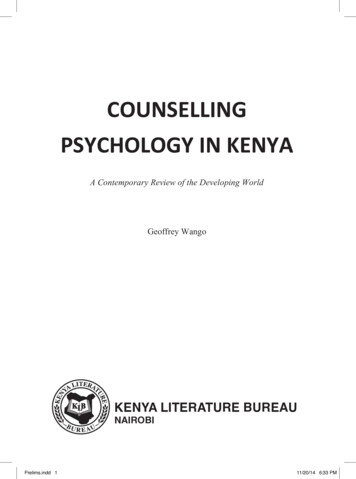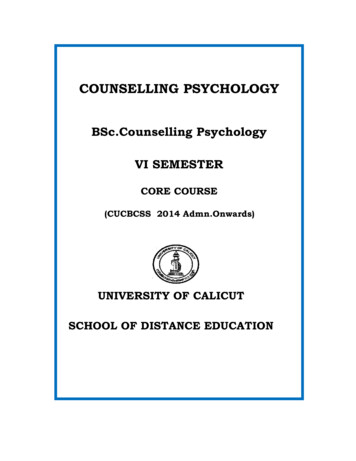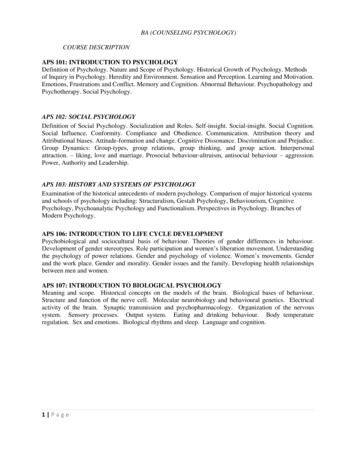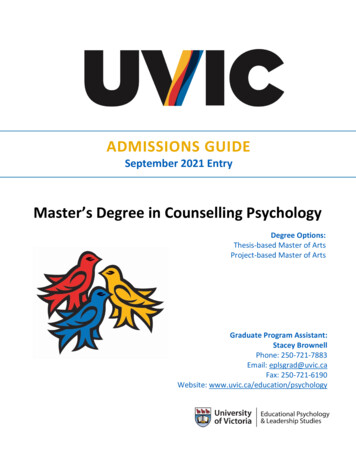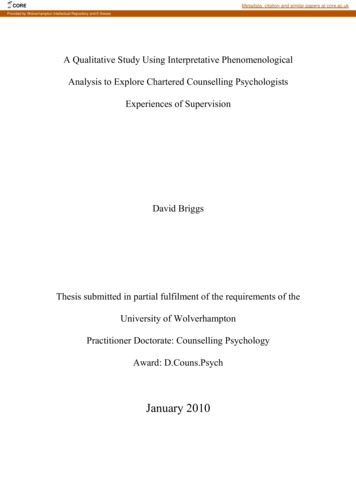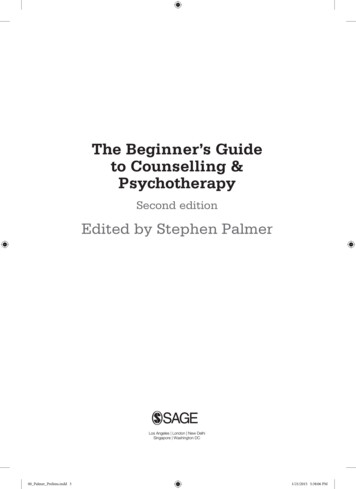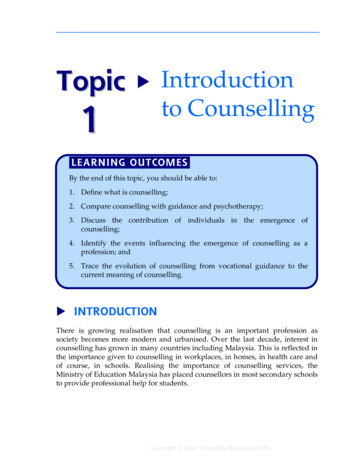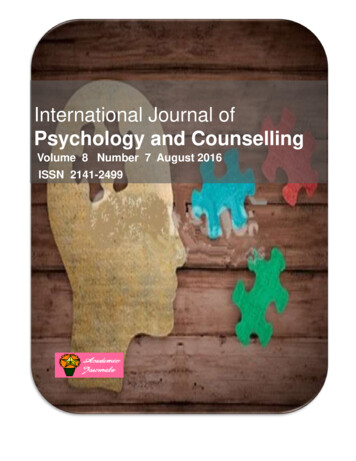
Transcription
International Journal ofPsychology and CounsellingVolume 8 Number 7 August 2016ISSN 2141-2499
ABOUT IJPCInternational Journal of Psychology and Counselling (IJPC) will be published monthly (onevolume per year) by Academic Journals.International Journal of Psychology and Counselling (IJPC) is an open access journal thatprovides rapid publication (monthly) of articles in all areas of the subject countertransference, Clinical psychology, Professional practice of behaviour analysis, Behaviouralmodel etc.The Journal welcomes the submission of manuscripts that meet the general criteria ofsignificance and scientific excellence. Papers will be published shortly after acceptance. Allarticles published in IJPC are peer-reviewed.Contact UsEditorial Office:ijpc@academicjournals.orgHelp ww.academicjournals.org/journal/IJPCSubmit manuscript onlinehttp://ms.academicjournals.me/
EditorsProf. Ahmed Awad Amin MahmoudFaculty of Education and Higher EducationAn-Najah National University,Nablus.Palestine.Dr. Marta Manrique GómezMiddlebury CollegeDepartment of Spanish and PortugueseWarner Hall, H-15Middlebury, VT 05753USA.Dr. R. Joseph PonniahDepartment of Humanities (English)National Institute of TechnologyTrichirappalli, Tamil NaduIndia.Dr. Yanjiang Teng801 Cherry Lane, APT201East LansingMichigan State UniversityMI 48824USA.Dr. Kanwar Dinesh Singh# 3, Cecil Quarters,Chaura Maidan, Shimla:171004 HPIndia.Prof. Radhakrishnan NairSCMS-COCHINAddress Prathap Nagar, Muttom, Aluva-1India.Dr. S. D. SindkhedkarHead, Department of English,PSGVP Mandal's Arts, Science & Commerce College,Shahada: 425409, (Dist. Nandurbar), (M.S.),India.Prof. Lianrui YangSchool of Foreign Languages, Ocean University of ChinaAddress 23 Hongkong East Road, Qingdao,Shandong Province, 266071 PChina.
Editorial BoardDr. Angeliki Koukoutsaki-MonnierUniversity of Haute AlsaceIUT de Mulhousedep. SRC61 rue Albert CamusF-68093 MulhouseFrance.Dr. Martha ChristopoulouGreek Ministry of NationalEducation & Religious AffairsXanthoudidou 2-4Athens,Greece.Dr. Zeynep OrhanFatih University Hadımköy 34500 IstanbulFatih University Computer Engineering DepartmentTurkey.Dr. Tahar LabassiUniversity of Tunis94 Avenue 9 Avril, Tunis 1007Tunisia.Benson Oduor OjwangMaseno UniversityP.O.BOX 333, MASENO 40105Kenya.Lydia Criss MaysGeorgia State University30 Pryor Street, Suite 550USA.Dr. Daniel HuberUniversié de Rennes 263, rue des Vinaigriers, 75010 ParisFrance.Naomi NkealahUniversity of the Witwatersrand, JohannesburgEnglish Academy of Southern Africa, P O Box 124, Wits2050South Africa.Yah Awg NikCentre for Language Studies and Generic Development,Universiti Malaysia Kelantan,
International Journal of Psychology and CounsellingTable of Contents:Volume 8Number 7August 2016ARTICLEThe framework for integrating common and specific factors in therapy: A resolution 81Yii-Nii Lin
Vol. 8(7), pp. 81-95, August, 2016DOI: 10.5897/IJPC2016.0398Article Number: FF3FDA560309ISSN 2141-2499Copyright 2016Author(s) retain the copyright of this tional Journal of Psychology andCounsellingReviewThe framework for integrating common and specificfactors in therapy: A resolutionYii-Nii LinCenter for Teacher Education, Graduate Institute of Learning Sciences, National Tsing Hua University, Taiwan.Received 2 March, 2016; Accepted 19 August 2016A framework for integrating common and specific factors in therapy is provided in this study. The keyto integration is employing the common factors as fundamental principles; meanwhile, incorporating aspecific model and unique techniques carefully to respond to the client’s needs, demographicvariables, and ethnic/cultural characteristics. The four major constructs of common factors (that is,client characteristics, therapist characteristics, process of change, and therapeutic context) arediscussed. The four important therapy paradigms (analytic-dynamic, cognitive-behavioral, humanisticexperiential, and systemic therapies), in which the important specific factors are derived from, are alsodelineated. The author revised and extended the generic model and the process-based model toprovide a better framework in understanding both types of factors. The main features of these twomodels have been integrated within the three phases: pre-therapy, process of therapy and post-therapy.In order to enhance the optimal effectiveness of therapy, the integration should follow three principles:using the findings of empirical studies, matching the client’s variables, and responding to the notion ofmulticultural counseling. Implications for therapy research, training/education and clinical practice arehighlighted.Key words: Common factor, specific factor, counseling, psychotherapy.INTRODUCTIONThe framework for integrating common and specificfactors in therapy: A resolutionPsychotherapy typically comprises of specific ingredients,and each of these ingredients requires many relatedtherapeutic actions. Therapists usually adhere to and relyon a specific approach and unique techniques inconducting interventions (Parsons and Zhang, 2014;Prochaska and Norcross, 1999). They consider some ofthe approaches more effective than others. The adoptedspecific theoretical approach and techniques are oftenargued to be responsible for therapeutic gains.Despite the provision of diverse therapeuticapproaches, literature noted a few differences intreatment efficacy among them (Sexton et al., 1997;Wampold, 2001). If differences do exist, they appear tobe extremely small at best (Wampold et al., 1997). Anydegree of client change may be attributed to a commonprocess shared by all approaches, instead of specificingredients utilized by only a few (Lambert, 1991; Sextonet al., 1997; Wampold, 2015). There is evidence thatcommon factors across various therapeutic schoolsE-mail: ynlin@mx.nthu.edu.tw.Authors agree that this article remain permanently open access under the terms of the Creative Commons AttributionLicense 4.0 International License
82Int. J. Psychol. Couns.contributed much more than specific ingredients to thetherapy outcome variation. Common factors couldaccount for 30% of variation among clients’ improvementwhile only 15% by specific psychological techniques(Lambert and Cattani-Thompson, 1996; Sexton et al.,1997). Their finding highlighted the importance offocusing on common factors in all therapies. The debateon specific technical factors vs. common/non-specificfactors has been gaining attention (Garfield, 1992; Stileset al., 1986; Parsons and Zhang, 2014). Some scholarsemphasized and advocated the importance of commonfactors that therapists should discard the traditional singletherapy approach and rely on a common instead ofspecific factors in conducting therapeutic interventions(Lambert et al., 2004; Patterson, 1984). They haveconsidered common factors to be necessary andsufficient in the therapeutic process.Berman and Norton (1985) emphasized the importanceof identifying factors common to all forms of treatmentrather than from examining features specific to particulartherapies. Messer and Wampold (2002) pointed out thewidespread operation of common factors in therapy.Young (1992) proposed a REPLAN model focusing onthe utilization of common factors in therapeutic treatment.This model is based on curative factors—the dimensionsunderlying all approaches: relationship, efficacy and selfesteem, practicing new behaviors, lowering or raisingemotional arousal, activating expectations of help,motivation and providing new learning experiences, andchanging perceptions (Frank and Frank, 1991). However,some other scholars have acknowledged common factorsas an important component of change but have not ruledout the possible role of the unique techniques (Wampold,2001, 2015). Both common and unique factors areimportant and necessary in the therapeutic process(Goldfried, 1991; Wampold, 2015; Warwar andGreenberg, 2000), especially the interrelationshipsbetween both types of factor (Arkowitz, 2003).Should therapists follow the traditional style of adoptingone specific approach to conduct interventions? Orshould they employ common factors instead of specifictechniques in therapeutic interventions? How should theyhandle both common factors and specific componentsduring the process of therapy? The purpose of this studyis to provide a resolution in the debate between commonand specific factors through an integration of the two.Common and specific factors are elaborated in the nexttwo sections respectively, followed by a delineation onthe integrative conceptual framework of both. The term of“therapy” in this article refers to a broad scope of differentstyles of counseling and psychotherapy. Similarly, theterm “therapist” refers to various professionals incounseling and psychotherapy fields.COMMON FACTORSCommon factors are the similarities between differenttheoretical models. They are the active elements oressential ingredients across all counseling andpsychotherapy approaches (Frank and Frank, 1991;Leibert et al., 2011; Weinberger and Rasco, 2007).Strupp (2001) identified that the outcome of a counselingand/or therapeutic process was frequently affected by thepersonal characteristics of the counselor/therapist andthe client’s positive feelings—non-specific (common)factors—which can elicit the positive therapeuticemotional and interpersonal interactions.In organizing these common factors, the threedimensions a client’s characteristics, a therapist’scharacteristics, and the process of change (Lambert andOgles, 2004) can serve as a reference. These dimensionscorresponded to the three major sets of variables (that is,client’s, therapists and process) in counselingintervention. Lin (2005) proposed a process-basedconceptual framework which included an additionalconstruct—a therapeutic context or healing setting.The therapeutic process and its outcomes are firstinfluenced by various preexisting characteristics (inputvariables) from both the client and therapist.Subsequently, when both parties get involved in theprocess of change, the major constructs—therapeuticrelationship, therapeutic techniques, placebo, expectancy,hope and rituals—interacted closely within a holisticframe of the therapeutic context.Client’s characteristicsThe client is the chief agent of change in therapy(Duncan, 2002). He/she is the most potent contributor tothe outcome in therapy (Lambert and Cattani-Thompson,1996; Miller et al., 1997; Sexton et al., 1997). Among aclient’s various characteristics (for example, innerstrengths, religious faith, goal directedness, personalagency, motivation, persistence, and capacity forchange), his/her expectation is an active ingredient andhas been confirmed as an important common factor(Sexton et al., 1997; Walborn, 1996). A positiveexpectation hope or faith is conceptualized as a criticalprecondition and is the most cited common factor fortherapy to continue (Grencavage and Norcross, 1990;Prochaska and Norcross, 1999). Therapy can be viewedas a process in which the therapists induce anexpectation in the client that treatments will heal him/her.Any positive change is a function of the client’sexpectation to improve (Prochaska and Norcross, 1999).Therefore, the client’s willingness to change is viewed asan extra-therapeutic factor (Wampold, 2015). Furthermore, a client’s experience and/or emotional involvementin therapy, as a means for him/her to engage in anaffective problem-solving process (Greenberg et al.,1993), is a common factor related to change in manytherapeutic approaches (Bohart and Wugalter, 1991;Castonguay et al., 1996).
LinTherapist’s characteristicsThe common factors concerning the therapists are theircharacteristics, such as warmth and empathy (Brown,2015; Moss and Glowiak, 2013), and unconditionalpositive regard in therapy (Brown, 2015; Grencavage andNorcross, 1990; Lambert and Cattani-Thompson, 1996;Moss and Glowiak, 2013; Patterson and Watkins, 1996;Prochaska and Norcross, 1999). These therapistfacilitative qualities (for example, honesty, support,empathy, genuineness, caring, acceptance, opennessand respect) exert their effects by enhancing thetherapist’s role as a benevolent agent of influence(Beutler et al., 1995; Brown, 2015; Moss and Glowiak,2013).Moreover, Whitbourne (2011) organized positive andcommon qualities of therapists into three categories:possession of a sophisticated set of interpersonal skills,the ability to help the client build trust in the therapist, andhave a willingness to establish an alliance with the client.Other characteristics played active roles in the client’simprovement are therapist’s expectation for improvement,ability in persuasion, demonstration of warmth, attention,understanding and encouragement, and central topsychological interventions (Lambert and CattaniThompson, 1996; Moss and Glowiak, 2013). Thetherapist’s professional status or reputation andcompetences (efor example, communication ability,caring, understanding, encouragement, persuasion, andintegration) have also been identified as important factors(Frank and Frank, 1991).Process of changeWhat is common to successful therapies is the processconducted by a skilled therapist who helps the client getsinvolved (Nelson-Jones, 2013; Sexton et al., 1997). Lin(2005) proposed the process of change as a commondimension with five aspects:83two parties is important in therapy (Ardito and Rabellino,2011; Grencavage and Norcross, 1990; Norcross et al.,1990; Prochaska and Norcross, 1999). It has also beenidentified as a major ingredient for behavioral change(Beutler et al., 1986; Frank and Frank, 1991;Sangganjanavanich and Reynolds, 2015). A goodtherapeutic alliance is related to positive outcomesacross various therapeutic modalities (Ardito andRabellino, 2011; Horvath and Greenberg, 1994;Luborsky, 1994; Moss and Glowiak, 2013; Safran andMuran, 1996).Therapeutic techniquesCombinations of affective, experiential, cognitive andbehavioral regulations are common techniques intherapy. Lambert and Bergin (1994) identified threecategories of common techniques: supportive (forexample, reassurance, trust, empathy and catharsis),learning (for example, cognitive learning, advice, affectiveexperiencing, and feedback), and action (for example,behavioral regulations, cognitive mastery, and practicingnew behaviors). Other common techniques consist oftherapists’ feedback for promoting awareness, correctiveexperience, and continued reality testing. Majortherapeutic techniques common across schools sharecertain effects on outcome variance, such as correctiveemotional experiences (Arkowitz, 2003; Frank and Frank,1991), self-understanding (Brown, 2015; Luborsky,1984), feedback (Brown, 2015; Lambert and Bergin,1994), cognitive insight (Frank and Frank, 1991),emotional catharsis (Applebaum, 1982; Grencavage andNorcross, 1990), emotional arousal (Frank and Frank,1991; Luborsky, 1984), reality testing (Goldfried, 1982),and communication, action, problem-solving, coaching,thinking and reflecting feelings (Brown, 2015; Culley andBond, 2011; MacCluskie, 2010; Nelson-Jones, 2013).Placebo, hope, and expectancy1. The therapeutic relationship2. Therapeutic techniques3. Placebo, hope, and expectancy; and4. Rituals.In addition, a therapeutic context as a healing setting iscrucial for clients’ making changes.Therapeutic relationshipThe therapeutic relationship is common and essential toall approaches (Bordin, 1994; Castonguay et al., 1996;Carr and Szymanski, 2011; Gross and Capuzzi, 2001;Moss and Glowiak, 2013; Nelson-Jones, 2013). Thedevelopment of a strong therapeutic alliance between the“Placebo, hope, and expectancy” could contribute asmuch as 15% of the therapy outcome variation (Assayand Lambert, 1999). The placebo effect is an importantcomponent, and perhaps the entire basis for theexistence, popularity, and effectiveness of therapy(Snyder et al., 1999). The curative effects come from thepositive and hopeful expectations that accompany theuse and implementation of methods and techniques(Frank and Frank, 1991; Sangganjanavanich andReynolds, 2015; Wampold, 2015; Weinberger, 1995).The power of expectation evokes from the therapist’sbeliefs in therapy and human being’s capacity for change.The therapist expects the client to change as a result ofthe particular interventions and active participation in theprocess. Meanwhile, the client must be able to engage in
84Int. J. Psychol. Couns.the process of self-exploration and be motivated tochange.RitualsRituals are a shared characteristic of healing proceduresin many cultures (Frank and Frank, 1991). The therapistand client both need a structured, concrete method ofritual for mobilizing therapeutic factors. The use of ritualsin a therapeutic context inspires hope and a positiveexpectation for change by conveying that the userpossesses a special set of skills for healing (Hubble etal., 1999). In successful therapies, both parties mustbelieve in the restorative power of the treatment’sprocedures (that is,rituals) (Frank, 1973). A rational,conceptual schema offers a plausible explanation for theclient’s symptoms and prescribes a ritual or proceduresfor resolving problems (Frank, 1982; Tinsley, 2000).2. Think about the world in less maladaptive ways3. Rely less on dysfunctional schemas (cognitivebehavioral treatments)4. Improve interpersonal relations (interpersonal therapyand some dynamic therapies)5. Accept one’s self (self-compassion therapies,acceptance and commitment therapy)6. Express difficult emotions (emotion-focused anddynamic therapies), and/or7. Take the perspective of others (Wamplod, 2015).Based on therapeutic orientations,categorized into four broad systems:theycanbe1. Psychodynamics2. Cognitive-behavioral or behavioral3. Humanistic-experiential, and4. Systemic (family) approaches (Casas, 1995; Orlinskyand Howard, 1995; Wachtel and Messer, 2003).Therapeutic contextPsychodynamic approachThe healing context and its meaning attributed by thetherapist and the client are critical contextual phenomena(Frank and Frank, 1991). A healing setting—a safeenvironment—heightens the client’s expectation from ahealer (Frank, 1982). A provision of new learningexperiences is not therapeutic unless the client perceivesthat the therapy is taking place in a healing context.Beutler et al. (1995) proposed four basic aspects oftreatment context: the treatment location or setting(where), the intensity of treatment (how much), themodality through which treatment is delivered (what kind),and the format in which this modality is transmitted (withwhom). Wampold (2015) proposed a common factormodel (contextual model) which contains three pathways:the real relationship, the creation of expectations throughexplanation of disorder and the treatment involved, andthe enactment of health promoting actions. Before thesepathways can be activated, an initial therapeuticrelationship must be established.The psychodynamic therapies include classicalpsychoanalysis and its early variants, as well as variousanalytically orientedtreatments.Thisapproachemphasizes the client’s early life experiences, earlymotivations which client is unaware of, situations ofconflict between motives, the salience of motivationalforces, and the role of unconscious forces on determiningand directing his/her mental life (Orlinsky and Howard,1995).Psychopathology arises from unconscious pathogenicideas of false beliefs that are usually based on traumaticchildhood experience (Deveaux, 2014; Warwar andGreenberg, 2000). A therapist typically aim to provide theclient with insight on their unconscious motivations as ameans toward resolving conflicts and redirecting energiestoward current life tasks (Corey, 2012; Orlinsky andHoward, 1995; Prochaska and Norcross, 1999). Thetherapeutic conceptualization and actions (for example,free association, interpretation of dreams, transference)are responsible for the therapy outcomes (Orlinsky andHoward, 1995). The client must uncover, process, workthrough unconscious mental forces and early lifeexperiences that could be the basis for problematicthoughts and behaviors (Casas, 1995; Wachtel andMesser, 2003). Psychodynamic therapy focused on thenotions of the unconscious mind, libido, transference anddefense mechanisms; and psychoanalysis is a methodfor treating mental illness via dialogues between theclient and psychoanalyst (Wright, 2013).The key change process is to provide the client withinsights on his/her problem through interpretation(Deveaux, 2014; Warwar and Greenberg, 2000). Theinvestigation of the interpretation of transference toextract a client’s underlying pattern of conflictual themescan guide the therapist in determining a treatment focus,SPECIFIC FACTORSThe proliferation of therapeutic schools has reached asmany as 400 (Bergin and Garfield, 1994; Karasu, 1986;Prochaska and Norcross, 1999). Each treatmentmodel/approach utilizes specific ingredients targeted toremediate a particular psychological deficiency (Wampold,2015). Every therapeutic approach has its ownuniqueness, such as philosophical stance, problemconceptualization, theoretical constructs, therapeuticprocedures and techniques. Often, the therapist wouldinduce a client to:1. Enact some healthy actions
Linas well as, in making interpretations of the client’s wishestoward other people, expected responses of others andresponses of the self (Luborsky, 1994). The therapistmust develop:1. A complex collaboration between himself/herself andthe client, and2. A working response to an interpretation through theresults of precondition, interpretation and responseoperation.Cognitive-behavioral approachA cognitive-behavioral therapy (CBT), integrates bothbehavioral and cognitive treatments, aim to correctmaladaptive patterns of behavior and thought byweakening or suppressing old habits and reeducating theclient with more effective cognitive and interpersonalskills (Corey, 2012; Kalodner, 2011; MacCluskie, 2010;Orlinsky and Howard, 1995; Porter, 2014; Prochaska andNorcross, 1999). The ingredients of any treatment aregrounded on the scientific understanding of behaviors(Fishman and Franks, 1992). There are three generalclasses of specific ingredients:1. Behavioral activation2. Activation and modification of dysfunctional thoughts;and3. Identification and modification of more stable patternsof thought (Jacobson et al., 1996; Meichenbaum, 1997).Research supports the effectiveness of CBT. Throughreviewing a representative sample of 106 meta-analysesexamining CBT for various problems, the strongestsupport exists for the CBT of anxiety disorders,somatoform disorders, bulimia, anger control problems,and general stress (Hofmann et al., 2012). Afterretrospectively examining the outcomes of patients whoreceived group CBT for depression at a psychiatricoutpatient clinic between 2003 and 2013, Thimm andAntonsen (2014) supported that group CBT for depressionhas shown effectiveness can be delivered in routine caresettings. CBT is effective for treating insomnia whencompared with medications, and its effects may be moredurable than medications (Mitchell et al., 2012).A behavioral therapy incorporates operant and classicallearning paradigms to modify maladaptive behavior andthought patterns (Casas, 1995; Trolley and Siuta, 2014).A therapist facilitates a client’s therapeutic changes bychallenging his/her beliefs with behavioral experimentsfor hypothesis testing. Specific ingredients, such ascounterconditioning, stimulus control, contingencymanagement, relaxation training, psychoeducation, andstress management, will be included in therapies (Casas,1995; MacCluskie, 2010; Porter, 2014; Prochaska andNorcross, 1999).85Cognitive therapists regard that an individual’semotional and behavioral responses to a situation arelargely determined by how he/she perceives, interpretsand assigns meanings to that event (Kalodner, 2011;Porter, 2014; Warwar and Greenberg, 2000). They viewedpsychopathology as systematic information-processingbiases (Beck, 1997). A cognitive therapy is usually astructured, time-limited approach in which the therapisttakes an active role in collaborating with the client tochange his/her dysfunctional beliefs. Therapeuticinterventions are tailored to a particular client’s difficultieswith a new emphasis on the role of specific types ofdysfunctional beliefs for the problems presented (Beck,1997; Beck, 2011). The primary mechanism of change isto alter core cognitive schemas targeted by specifictechniques, such as the identification of distorted anddysfunctional cognitions, correction of faulty conceptionsand self-signals, and modifications of dysfunctionalthoughts and beliefs (Corey, 2012).Humanistic-experiential approachThe humanistic-experiential therapies focus on concrete,nonrational or prerational, symbolic aspects ofexperiences—emotion, bodily sensation and feeling,imagery, and imaginative fantasy—and the failure to giveadequate expression in consciousness and behavior(Orlinsky and Howard, 1995). This type of therapiesemphasizes in empowering individuals to act on the worldand to determine their own destiny (Casas, 1995; Wittyand Adomaitis, 2014). Major features consist of:1. A focus on present as opposed to past experiences.2. The importance of a therapeutic relationship in whichthe therapist is empathic, caring, genuine, andnonjudgmental; and3. Central goals of therapy that include increasedindividual autonomy, independence, and self-actualization(Casas, 1995).Through creative self-expression, the reattunement orrecentering of consciousness in the flow of immediatesensory and affective experience, and the rebalancing orharmonizing of personal energies, the client can attainpsychological well-being (Orlinsky and Howard, 1995).The humanistic approach—focus on the process in thehere and now—see people as basically healthy (Corey,2012; MacCluskie, 2010; Warwar and Greenberg, 2000),emphasize the importance of the client-therapist relationship in promoting therapeutic changes (MacCluskie,2010; Watson and Greenberg, 1994), put therapeuticgoals as establishing congruence and acceptance ofclient’s responsibility (MacCluskie, 2010), and value thetherapist’s presence as being highly therapeutic (Watsonet al., 1998). The primary task in humanistic therapies isto facilitate the client’s experiences, particularly in those
86Int. J. Psychol. Couns.to problematic areas that he/she shows concerns (Corey,2012; Greenberg et al., 1993).Systemic therapySystemic therapy is primarily about understanding ideasin the wider social context. The client’s improvement isviewed as modifications on the functional properties ofthe system rather than on his/her own characteristics. Apsychological symptom is considered to be maintained bya particular repetitive patterns of behavior organizedwithin a troubled social system. The therapist often looksinto the family system for indications of the problem andtargets interventions on the relationship system; anysymptom can thus be redefined as indicators for an entireecology of relationships (Goldberg et al., 2014; Keeney,1994). An alternative account of recurrent patterns ofbehavior, which focuses on behavioral maintenance inthe present by feedbacks within the system, can beoffered. The social context of the behavior is highlightedrather than the characteristics of the individual displayingthat behavior.Systemic family therapies—emphasize the exchangeand processing of information, conflict and the flow ofinfluence among intimates—are an active but indirectapproach to resolving problems (Goldberg et al., 2014;Orlinsky and Howard, 1995). This family systemperspective holds that symptoms are an expression of adysfunction within a family; these dysfunctional patternscould be passed down from several generations (Corey,2012; Goldberg et al., 2014). Systemic theorists believethat families are self-regulating and self-maintaining(Stevens, 2001), and many inner disturbances developedin a family or another relational context (Casas, 1995).The family play an important role in the development andmaintenance of pathology and dysfunction, thus, it ismore effective to work with a family or a relational systemthan with an isolated individual.INTEGRATING COMMON AND SPECIFIC FACTORSSeveral proposed models have attempted to draw arelationship between common and specific factors in thetherapeutic process. Two representative models are theGeneric Model (GM) by Orlinsky et al. (2004) and theProcess-based Model (PM) by Sexton et al. (1997). Briefintroductions of these two models are delineated below,followed by a description of the proposed framework ofintegrating important components of these two models tosynthesize common and specific factors effectively.The GM distinguishes therapeutic process as a systemof action from other larger surrounding systems whichserved as functional environment. It emphasizes ontreatment specificity and the matching of technique to theclient and problem, as well as on using empirical data todetermine choice of therapy. This model alsoconcentrates on the matching of a broad array of clientvariables, treatment variables, and outcome. Monitoringvariables, such as therapist characteristics (for example,experience, attitudes and beliefs), client characteristics(for example, symptom complexity, coping style andresistance to influence), technique variables (forexample, muscle relaxation skills, empty chair, role andplay) and interactions among these variables areessential. Each form of therapy, as stated by this model,involves a particular configuration of these processfacets. There are always some therapeutic contractswhich entail specific therapeutic operations. In the courseof therapy, the client and the therapist form a therapeuticbond and experience specific modes of self-relatedness,through which they attain some in-session impacts.Furthermore, these facets interact with each other as atemporal pattern of events.PM proposes that t
International Journal of Psychology and Counselling (IJPC) is an open access journal that provides rapid publication (monthly) of articles in all areas of the subject counter transference, Clinical psychology, Profession
